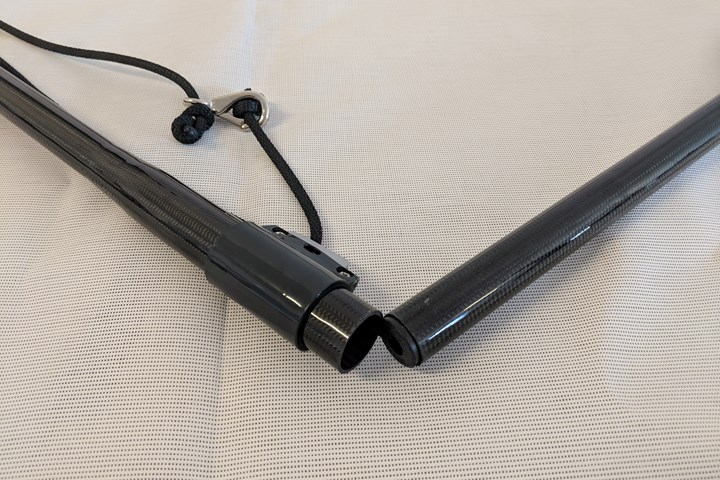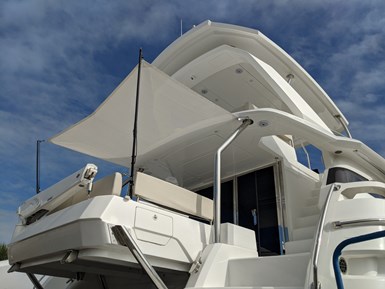Share

Nanette Hultgren, owner of Shellback Canvas LLC (Palmetto, Fla., U.S.), has been in the marine fabrication business for 33 years, developing and building products such as canvas awnings for fishing boats and, more recently, awning support poles. One challenge in this business, she says, was that for years, the state-of-the-art aluminum and PVC support poles on the market were not strong enough to withstand the high winds on a boat during use. Stainless steel poles, though stronger, were too heavy and stiff, and not easily storable. A few carbon fiber options were available, and showed potential to meet both the requirements for stiffness and light weight, but they were made from prepreg fabrics that Hultgren says were prohibitively expensive.
About 10 years ago, Hultgren decided to try to develop her own carbon fiber composite poles for use with her canvas awnings. The goal was to develop a cost-effective solution that met the specific requirements for her two-piece breakdown awning poles.
After some market searching and trial and error, Hultgren decided to try braided carbon fiber sleeves from A&P Technology (Cincinnati, Ohio, U.S.) infused with epoxy. To achieve the desired thickness and stiffness, two braided sleeves form the inner and outer layers, with a unidirectional (UD) carbon fiber sleeve layer in the middle. First, she tried a wet hand layup, but the combination of the three material layers was too thick for the resin to properly infuse. Next, she enlisted the help of a composites professional, who developed a two-part mold out of fiberglass on which to vacuum infuse the parts. However, the cylindrical shape of the poles proved too complex for infusion, and Hultgren realized that some type of pressure would be needed to properly infuse the braid with resin.
Ultimately, Hultgren designed a two-part aluminum mold with clamps for pressure. Her process uses a patented thin-wall plastic tube as a left-in mandrel, with a removable support tube to maintain shape. A patented mold release liner was also designed to prevent the liquid epoxy from contacting the mold directly and to help draw the epoxy over the tube before pressure is applied.
To make the final product, two poles are manufactured and then connected via a patented carbon fiber composite socket, forming a breakdown point for easy stowage.

In the final, patented process, the mold release liner is inserted into the mold, followed by the braided sleeves and mandrels. Liquid epoxy is poured into the mold, making sure the entire pole is covered. Then pressure and heat are added.
The resulting rods exhibited the light weight, durability and flexibility needed. Sold and marketed as Blackstick for the past four years, Shellback Canvas LLC sells a carbon fiber socket breakdown pole for rod holder shades and rocket launcher shades for boats.
Hultgren notes that now, there are several carbon fiber prepreg pole options on the market. “Prepreg is easier to source and manufacture for those new to composites, but braid outperforms prepreg rods in this application,” she says. “They are tougher, more flexible, with no delamination.”
Shellback Canvas LLC now solely produces Blacksticks to keep up with growing demand for the product, Hultgren says. Ultimately, she says she could see her process and liner being used for other cylindrical part applications, in oil and gas or other markets. “Prepreg and filament winding are the state of the art when it comes to rods and tubes, and they have their advantages. But I think braid has a lot of potential that hasn’t been seen yet.”
Related Content
Natural fiber composites: Growing to fit sustainability needs
Led by global and industry-wide sustainability goals, commercial interest in flax and hemp fiber-reinforced composites grows into higher-performance, higher-volume applications.
Read MoreInfinite Composites: Type V tanks for space, hydrogen, automotive and more
After a decade of proving its linerless, weight-saving composite tanks with NASA and more than 30 aerospace companies, this CryoSphere pioneer is scaling for growth in commercial space and sustainable transportation on Earth.
Read MoreBio-based acrylonitrile for carbon fiber manufacture
The quest for a sustainable source of acrylonitrile for carbon fiber manufacture has made the leap from the lab to the market.
Read MoreThe potential for thermoplastic composite nacelles
Collins Aerospace draws on global team, decades of experience to demonstrate large, curved AFP and welded structures for the next generation of aircraft.
Read MoreRead Next
Plant tour: Daher Shap’in TechCenter and composites production plant, Saint-Aignan-de-Grandlieu, France
Co-located R&D and production advance OOA thermosets, thermoplastics, welding, recycling and digital technologies for faster processing and certification of lighter, more sustainable composites.
Read MoreDeveloping bonded composite repair for ships, offshore units
Bureau Veritas and industry partners issue guidelines and pave the way for certification via StrengthBond Offshore project.
Read MoreAll-recycled, needle-punched nonwoven CFRP slashes carbon footprint of Formula 2 seat
Dallara and Tenowo collaborate to produce a race-ready Formula 2 seat using recycled carbon fiber, reducing CO2 emissions by 97.5% compared to virgin materials.
Read More

.jpg;width=70;height=70;mode=crop)





















